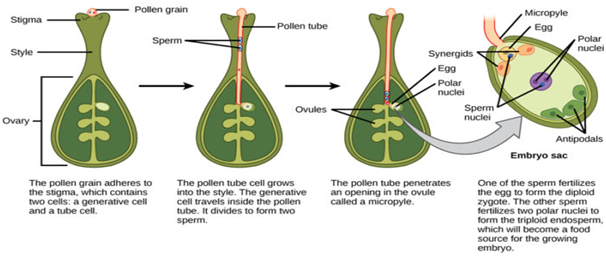Reproduction
Reproduction is the process by which all organisms multiply in number and increase their population.
Asexual reproduction
Asexual reproduction is a method of reproduction that involves only one organism. A single organism reproduces two or multiple organisms on its own. This is seen in all unicellular organisms, some multicellular organisms and a few plants.
Sexual reproduction
The mode of reproduction that involves two individuals; one male and one female. They produce sex cells or gametes which fuse to form a new organism.
Asexual Reproduction
Fission
- Fission is an asexual reproduction that is common in most of the unicellular organisms.
- When the fission results in two daughter cells, it is binary fission (e.g. paramecium).
- When fission results in many daughter cells, it is called multiple fission (e.g. Plasmodium).
- Planes of fission may be different for different organisms.
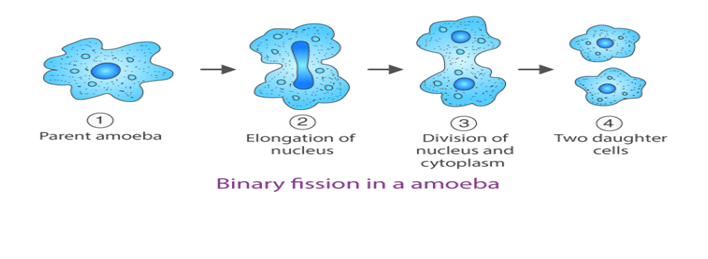
Budding
- Budding is a type of asexual reproduction in which a small cyst-like structure is formed on the parent’s body, which gives rise to a new individual.
- Bud may remain attached to the parent (yeast) or may separate and become a new individual (hydra).
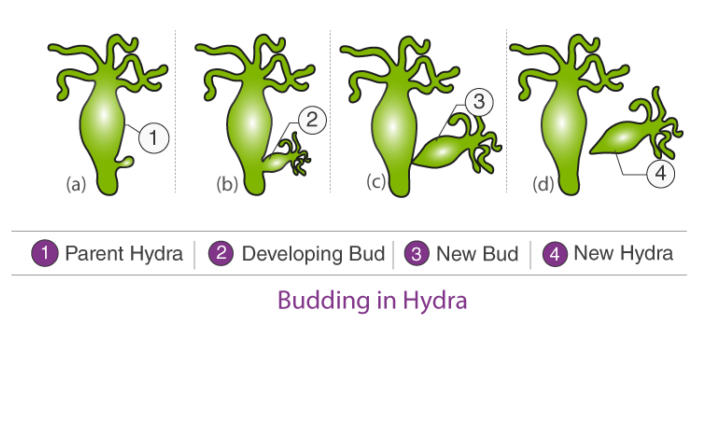
Regeneration and fragmentation
- Regeneration is the process of growing back the lost organ or body part by the organism (e.g. lizard).
- Fragmentation is the process by which an organism gets fragmented into smaller pieces and each piece grows into a whole new organism.
- E.g. Planaria, Hydra
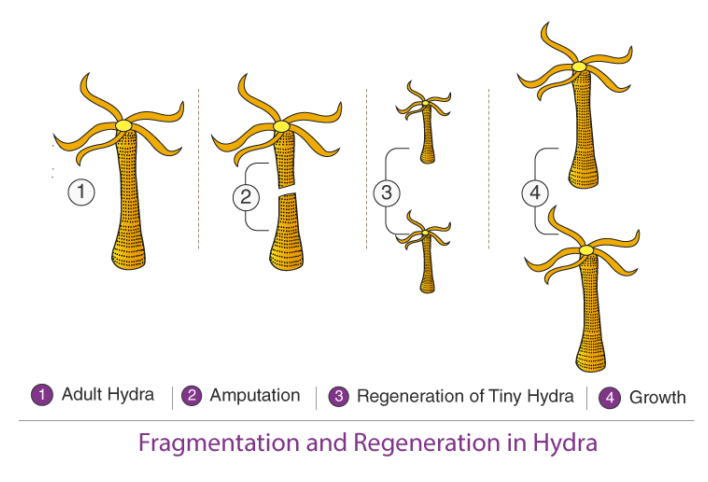
- Fragmentation and Regeneration in Hydra
Spore formation
Organisms such as fungi make spores that can grow into complete new individuals when dispersed from their fruiting body.
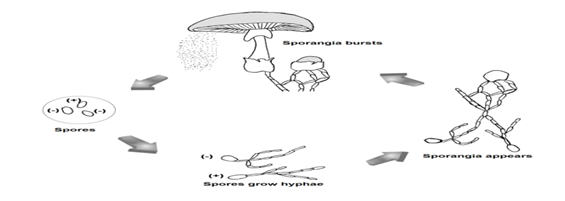
Vegetative propagation
- This is a type of asexual reproduction seen in plants.
- The vegetative part of the plant, like leaves, stem, roots, gives rise to a new plant.
- Vegetative propagation can be artificial or natural.
- Natural vegetative propagation happens through leaves (e.g. bryophyllum), stem (e.g. turmeric, ginger), runners/stolon (e.g.grass runners, strawberry), bulbs ( e.g. onion, lily), etc.
- Artificial methods include cutting, grafting, layering and plant tissue culture.
Sexual Reproduction
Types of Cell division
Two types of cell division seen in eukaryotic organisms:
Mitosis
- Takes place in somatic cells
- Maintains the chromosome number
- Produces two, diploid daughter cells
- Required for asexual reproduction, development and growth, cell replacement and regeneration
Meiosis
- Takes place in sex cells
- Reduces the number of chromosomes by half
- Produces four haploid daughter cells
- Required for sexual reproduction, i.e gamete formation
The Reproductive System
Male reproductive system
- The main reproductive organ in males is a pair of testes.
- They produce the male sex cells called sperms and also produce male sex hormone testosterone.
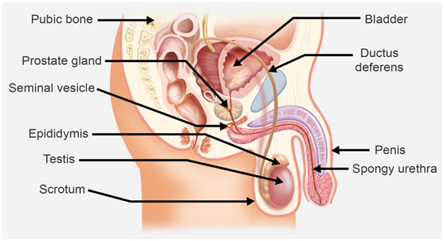
Male main reproductive organs
- The main reproductive organ in males is a pair of testes.
- They are present in scrotal sacs outside the body and contain seminiferous tubules as the structural and functional unit.
- Male sex cells, sperms, are produced by seminiferous tubules and mature in the epididymis.
- Leydig cells or interstitial cells present in between the seminiferous tubules secrete hormone testosterone.
Male accessory reproductive organs
- Several accessory reproductive organs that aid in the reproductive process.
- The prostate gland and the seminal vesicles are glands of reproductive system which make semen and nourish the sperms.
- Penis, having urethra passing through it, is called copulatory organ.
Male Ducts
- In males, the vas deferens and the urethra are the main ducts.
- A single vas deferens carries sperms from respective testis up to urethra.
- Urethra acts as a common passage for semen and urine.
Female reproductive system
The human female reproductive system consists of a pair of ovaries, a pair of fallopian tubes/oviducts and the accessory organs such as the uterus and the vagina.
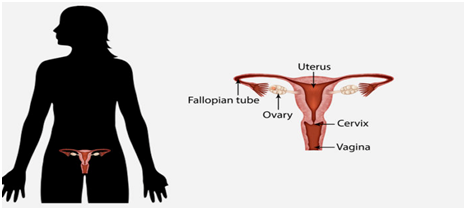
Female main reproductive organ
- The main reproductive organ in a female is a pair of ovaries.
- They produce the female sex cells called eggs or ova and also produce female sex hormones called estrogen and progesterone.
Female accessory reproductive organ
- Uterus and vagina are the accessory reproductive organs in human females.
- The uterus is the site of fetal development and vagina receives sperms from the male.
Menstrual Cycle
Menstruation
- Menstruation is the cyclic event of the release of the ovum from the ovary and its removal from the body when fertilization does not happen.
- During menstruation, the blood-rich endometrium of the uterus also breaks down while the ovum is being removed from the body.
- Two pituitary hormones, LH and FSH and two ovarian hormones, estrogen and progesterone, all have their roles in menstruation.
- In humans, the cycle repeats every 28 days.
Fertilization
Human reproduction
Humans reproduce sexually. The male produces sperms and the female produces eggs. When the sperm fuses with the egg, it forms a zygote that gives rise to a new progeny.
Contraceptive Methods
Reproductive health
Reproductive health deals with the prevention of STDs and unwanted pregnancy. Understanding the reproductive system is also a part of reproductive health awareness.
Contraceptives
- Contraceptives are devices that prevent unwanted pregnancy and help avoid STDs.
- Contraceptives can be of various types such as mechanical barriers, hormonal/chemical methods, surgical methods, etc.
Coitus Interruptus
- It is a very unreliable contraceptive method where the coitus is stopped before the male ejaculates inside the female reproductive tracts.
Rhythm Method
- Another unreliable method of contraception where coitus is avoided when the female is fertile and the chances of fertilization are very high.
Condoms
- One of the most effective methods of contraception.
- A mechanical barrier that stops the semen from entering the female tract preventing pregnancy.
- It also avoids the possibility of contracting STDs.
Diaphragms
- Diaphragms are barriers that can be added inside the female reproductive tracts.
- They stop the entry of semen inside the female tract and thus prevent pregnancy.
Contraceptive Pills
- Contraceptive pills are chemical methods of contraception.
- They change the level of hormones in the body that prevents the release of the ovum from the ovaries.
Emergency Pill
- Emergency pills are those pills which can be taken after coitus to avoid pregnancy.
- They quickly change the level of hormones in the body and prevent a successful implantation even if the egg gets fertilized.
IUD
- IUD stands for Intrauterine Device.
- They can be used for a couple of years.
- It is a device that is inserted into the uterus, changing its shape and preventing successful implantation of the zygote.
Sterilization
- Sterilization is a surgical method of going permanently sterile.
- This can be done in both males and females.
- In males, it is called vasectomy and in females, it is called tubal ligation.
Reproduction in Plants
Sexual reproduction in flowering plants
- Sexual reproduction in plants happens through flowers.
- Essential whorls of the flowers such as androecium and the gynoecium help in the sexual reproduction of plants.
Non-essential parts of flowers
- The typical structure of flower contains essential whorls and non-essential whorls.
- Sepals and Petals are called non-essential whorls as they do not directly take part in reproduction.
- Sepals protect the inner delicate whorl during bud condition and also perform photosynthesis if they are green in colour.
- Petals, when they are coloured, attract insects for pollination.
Essential whorls of flowers
- Androecium and gynoecium are called as essential/reproductive whorls of a flower.
- Androecium produces pollen grains containing male gametes and gynoecium produces ovules which are female gametes.
- Bisexual flowers contain both the whorls while unisexual flowers contain either of them.
- Each individual member of androecium is called a stamen and consists of anther and filament.
- Anther produces haploid pollen grains.
Each individual member of gynoecium is called pistil and consists of stigma, style and ovary.
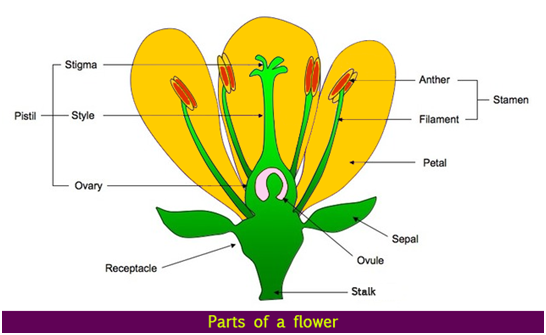
Pollination
The process of transfer of pollen grains from anthers to the stigma of a flower is known as pollination.
- It is required for fertilization.
- Pollination has two types, self-pollination (autogamy) and cross-pollination (allogamy).
- In self-pollination, transfer of pollen grains takes place from anthers to the stigma of the same flower or another flower of the same plant.
- In cross-pollination, pollens are transferred from anthers to the stigma of another flower.
- Many pollinating agents play their roles in cross-pollination. Examples: water, wind, insects, birds, bats, etc.
Fertilization
Fusion of male and female gametes is known as fertilization.
- In flowering plants after pollination, the pollens germinate on the stigma surface of pistil and generate two male nuclei.
- Ovule has egg cell and two polar nuclei.
- One male nucleus fuses with two polar nuclei and forms triploid endosperm.
- Another male nucleus fuses with the egg cell and forms the zygote that gives rise to the embryo and future plant.
- After fertilization, ovary becomes fruit and ovules turn into seeds. All other parts wither away.
